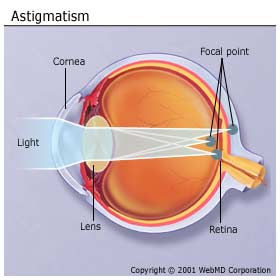 In order for the eye to work properly, light coming into the eye must be properly focused on the retina (or the back of the eye). When the image is not focused, there is an irregularity in the eye. This irregularity can be the overall shape of the eye or the curvature of the cornea (the clear outer covering of the eye), or both. The cornea should be curved equally in all directions. Astigmatism occurs when the cornea is curved more in one direction than another.
In order for the eye to work properly, light coming into the eye must be properly focused on the retina (or the back of the eye). When the image is not focused, there is an irregularity in the eye. This irregularity can be the overall shape of the eye or the curvature of the cornea (the clear outer covering of the eye), or both. The cornea should be curved equally in all directions. Astigmatism occurs when the cornea is curved more in one direction than another.
Astigmatism is quite common and, in the vast majority of cases, it is due simply to variations between people. Just as different people have different shaped feet or hands, people also have different shaped corneas. Rarely astigmatism is caused by lid swellings such as chalazia, and corneal scars, or by keratoconus (a rare condition in which the cornea becomes misshapen and pointed rather than smooth and rounded).
Astigmatism may cause blurred vision, eye strain or even headaches. It can also cause images to appear doubled, particularly at night. Small amounts of astigmatism can be ignored. But if any of its symptoms are present, astigmatism can be corrected by glasses or contact lenses. In most patients hard contact lenses do a better job of correcting for astigmatism than soft contact lenses.
(Information provided by Einstein Medical, Inc.)
